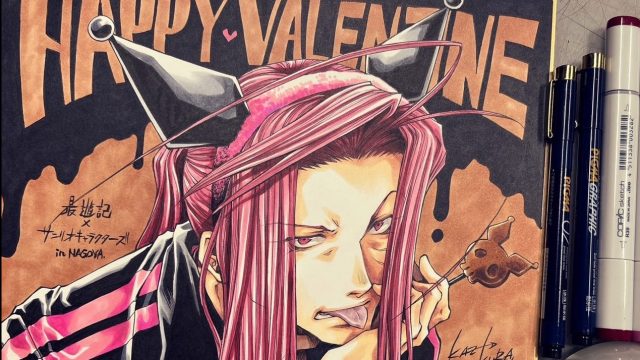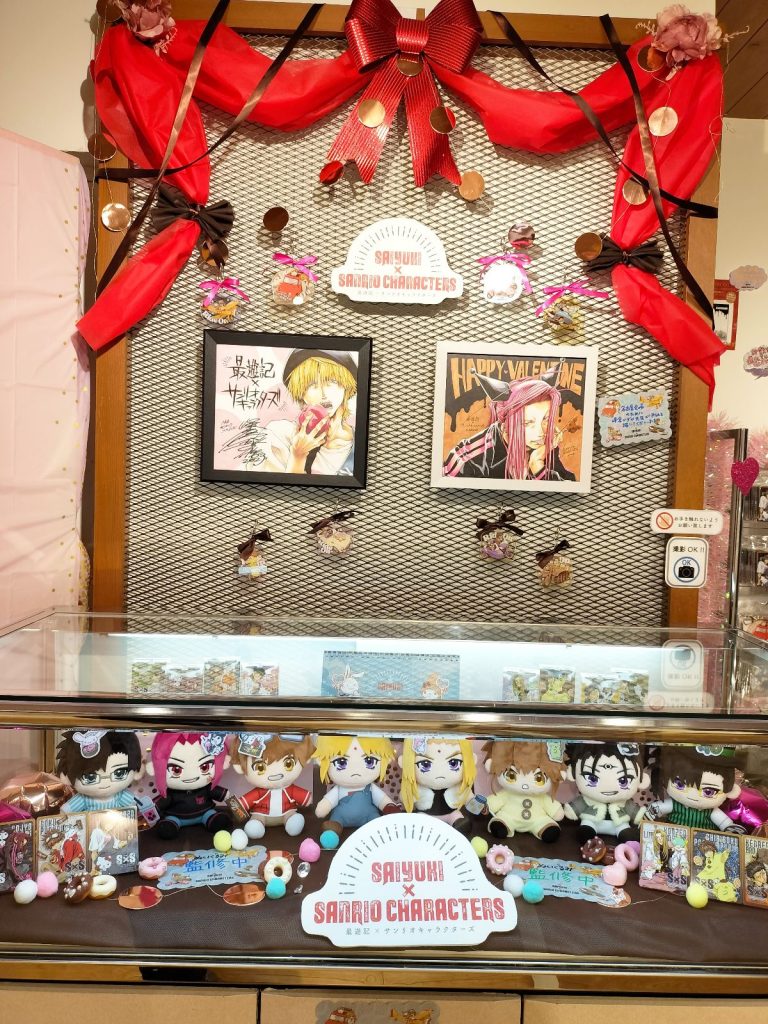Once upon a time, there was a baby in a basket, floating down a river.
No, not that baby. Let’s start over.*
The first chapter of Gensomaden Saiyuki landed in Monthly G Fantasy in October 1997, a remarkably assured debut from its 22-year-old creator, Kazyua Minekura. For those of you not familiar with the publishing quirks of manga, Monthly G Fantasy is pretty much what it says on the box, a monthly publication collecting serialized chapters of comics, and yes, many of them are fantasy.
In that October debut, Saiyuki checks all those boxes, with a relatively straightforward, violent introduction informing readers that the world is at stake and our somewhat reluctant heroes are the best hope to save it. The characters also announce what might as well be the thesis statement of the early series:
From the day I was born to the day I die, I’m on nobody’s side but my own.
Minekura will spend the next year, and the next twenty-five years, really, calling bullshit on that.
But I’m getting ahead of myself. Let’s get a few basics down.
Saiyuki, as it generally gets called, is one of the many retellings/reinterpretations of Journey to the West, a Chinese novel from the 16th century about a plucky and rebellious Monkey King (or Monkey, Sun Wukong, Son Goku…), the pious priest Tripitaka (Genjo Sanzo in Japanese), and their traveling companions Pigsy and Sandy. Journey to the West, which might be the most popular novel in East Asia (certainly in the top five) has a massivebig and influential footprint, directly inspiring adaptations like Saiyuki, the 1978 television show Monkey (also called Monkey Magic,its New Zealand-based successor The New Adventures of Monkey, and Dragon Ball. It’s lent heavy influence to countless more works, including One Piece and Inuyasha. It’s a bit like Shakespeare in the Western world; once you start looking, its influence is everywhere.
Saiyuki takes some obvious liberties from the opening pages, where we meet our leads, the Sanzo party (or Sanzo-ikkou in Japanese). The plucky and spirited Son Goku is a bit different than the novel, but the real changes are with the rest of the cast: the short-tempered and sour-faced Genjo Sanzo (Tripitaka), suspiciously polite Cho Hakkai (Pigsy), and insecure ladies’ man Sha Gojyo (Sandy). The Three Aspects, representations of the Buddhist order, have ordered these four west for plot reasons. They load up their Jeep (in a nod to the novel’s dragon that turns into a horse, they have a cat-sized dragon that turns into a Jeep), dodge some attackers, and head out. Sanzo is the only human in their little group. The other three are one variety or another of youkai, who in the world of Saiyuki are human-appearing but usually stronger and more directly connected to magical power.
In 1998, the manga gets down to the real business of things. In the early chapters, Sanzo is told that his ragtag party will hold together because they’re united by the scars of their pasts. This is true on two levels: all four of them have their own buckets of overlapping and complementary trauma, but they were also all connected by a rebellion in Heaven long in the past. As a result, Goku was imprisoned in a cave for five hundred years without most of his memories, and the other three were sent into a five-century cycle of reincarnation. This history is covered in a prequel manga, Saiyuki Gaiden, while the main Saiyuki manga takes on their baggage from the current incarnation.
And oh boy, there is a lot of baggage. Goku was locked alone for five hundred years without food, water, blankets or memories. He’s the youngest (as long as you don’t count that 500-year gap), and is honestly heroically well adjusted, given the circumstances, but he still struggles with fears of abandonment and a hunger that won’t go away. Sanzo was the one who broke him out of his cave, and he’s Goku’s emotional anchor, especially in the early chapters.
The first major arcs in Saiyuki focus on Gojyo’s and Sanzo’s backstories and their massive cases of survivor’s guilt. Gojyo has blood-red hair and eyes, indicating that he’s a child of taboo; his father was youkai and his mother human. This combination is rare enough that in twenty volumes, we don’t encounter anyone else like Gojyo, and most humans don’t even recognize what his hair and eyes mean. Gojyo’s parents died when he was very young, and he was raised by his half-brother and his father’s spurned wife. It started badly and ended worse, leaving preteen Gojyo on his own and without resources.
Sanzo’s early life was a lot more stable. He was found floating in a basket as an infant and was raised by his rescuer, a high-ranking Buddhist priest who makes Uncle Iroh seem uptight. It went well, until one horrible, rainy night left Sanzo on his own (though with access to resources that Gojyo could have only dreamed of). Two acts of violence a few years apart meant that both Sanzo and Gojyo lost their only anchors in an instant.
Both Gojyo and Sanzo watched loved ones die: Sanzo’s mentor and father figure died to protect him, and Gojyo’s half-brother killed his own abusive mother to protect him. It left both Sanzo and Gojyo alone far too young. Sanzo, armed with a pistol and a monastic title, pushed everyone away, insisting he needed no one; Gojyo, without resources beyond a pretty face and natural charm, pulled people into his orbit, but never let anyone get too close. It’s not really a surprise that they get on like oil and water, even compared to the rest of the feuding heroes. Of course, in the arc focusing on Sanzo’s past, Gojyo is the one sitting on the other side of the door when Sanzo hauls his still-healing body out of bed and heads out alone to settle things.
Scanlation by MangaCity.net. Note the panel reads right to left.
Of course, Gojyo is the one who lets him go, along with the hint that Sanzo needs to win his fight. They understand each other too well to get along, but it doesn’t mean that they don’t have each other’s backs.
These bonds get tested over the years and are almost broken once or twice, but so far, they’ve held.
Minkeura keeps the early cast pretty focused, but a few characters outside the Sanzo-ikkou get the spotlight, including the bodhisatta Kanzeon Botatsu** and hir long-suffering attendant Jiroushin, who set the Sanzo-ikkou off to save the world in the first place (and who knew all four of them back during that rebellion in Heaven), along with Genjo Sanzo’s mentor and father figure Koumyou. Koumyou Sanzo is probably the closest thing to a conventional moral center Saiyuki has, a dreamy, calm presence in a chaotic world. He doesn’t really have much “screentime” in the manga, but every time he appears, it makes an impact, and flashbacks to his life with Genjo Sanzo frame the last storyline of 1998. His words sum up Sanzo’s arc: Perhaps true freedom is having a home to return to.
In the following year, we’ll meet other antagonists, learn the source of the Minus Wave that the Sanzo party has been charged with stopping, and find out just what Cho Hakkai’s deal is (his emotionally scarring backstory does the neat trick of adding depth to his character and showing us how all four lead characters met. It’s also the first, but not the last, time that Minekura-sensei dips into horror). But none of what follows in 1999 and beyond would work without the solid ground that these first arcs establish: damaged, hurting people building connections almost in spite of themselves. Minekura gives her characters a home to return to: not a physical one unless you count the Jeep, but an emotional stability that builds to something essentially unbreakable.
Saiyuki has had its ups and downs since then. In addition to changing publishers (in Japan) a few times and losing its licensor in the United States, Minekura has faced a distressing series of health challenges that have put the manga on an uncertain, off-and-on hiatus for years. The last chapter was released in July 2022. But Minekura’s fans have hung on; there have been stage shows, multiple anime adaptations, a few novelizations, audio plays, and a traveling exhibition to celebrate the manga’s 25th anniversary. (The audio dramas have songs, too, including “Bad Friends” sung by Gojyo and Sanzo’s voice actors.) Until a few days ago, you could visit a pop-up shop as part of a collaboration with Sanrio (yes, Hello Kitty Sanrio), and some plushies are coming soon.
For myself, I’ll wait as long as it takes.
If you do want to check the manga out yourself, the Kodansha translations are generally more accurate (though less slangy and fun to read) than the older TokyoPop translations. These hefty hardcovers have slightly larger pages and therefore more of the original art, and — perhaps most importantly of all — are in print. Those volumes conclude at a pretty natural stopping point, just before Minekura changed publishers and the manga was retitled Saiyuki Reload. After that, it gets a bit dicier. All but the last volume of Saiyuki Reload were published by TokyoPop in English, and I was lucky enough to grab a Hong Kong English-language translation off eBay some years ago. The next manga, Saiyuki Reload Blast hasn’t been published in English at all. If you get hooked, though, you can find “scanlations” without too much trouble if you poke around.
* Yes, this does sound familiar. It’s one of those recurring things that shows up in stories humans tell about themselves.
** Gwan Yin/Kwanyin/Kannon, etc., who has been male, female, and both in global Buddhism, and is hermaphroditic in Saiyuki.*** Japanese doesn’t have gendered pronouns, and a lot of the fandom settled on various neoprounouns for hir. Not many of the characters in Saiyuki would identify as Buddhists, but Buddhism sure as fuck believes in them.
*** The English dub of the anime**** defaults to using female pronouns; the Japanese anime mostly ducks the question but does keep Kanzeon’s more masculine speech patterns.
**** The anime ducks several of the more, er, challenging details of the story overall. It’s also just not very good, though I do have a soft spot for it, and the Japanese voice acting is stellar. Ashida Ikira plays Cho Hakkai, which if you know your voice actors, is probably all I need to say about him.




